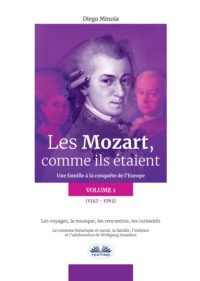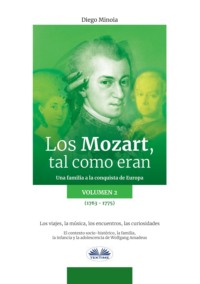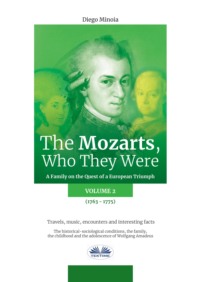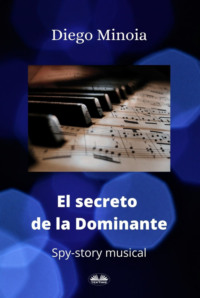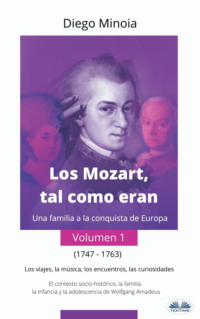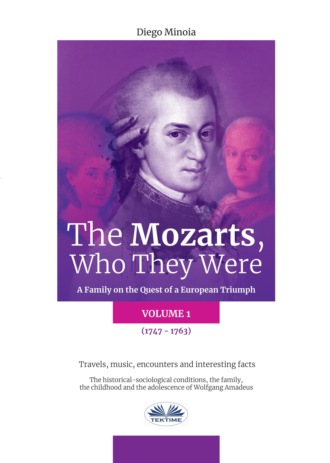
Полная версия
The Mozarts, Who They Were (Volume 1)
Interesting facts on Salzburg
Here are a few interesting facts related to daily life in Salzburg, some of which were recounted in Nannerl's diary, which help us better understand that faraway epoch and the quotidian of the Mozart family.
Flagellated in the Town Hall: when girls were "discovered" morally misbehaving regarding their sexual conduct, they were publicly whipped in the Town Hall and sent to a "correctional home". On 11 August 1775, this happened to seven maids.
Grenadiers: when the Archbishop traveled outside of the city, he was escorted by numerous grenade throwing soldiers who were guards of honor and served to protect against potential attacks. Nannerl writes of 40 soldiers in her journal.
The pardon: for the occasion of Holy Friday, The Confraternity Brotherhood of Trinity obtained the privilege to request the pardon for the death sentence of a mill worker who had killed a judicial officer, as recorded by Nannerl.
Dangers in the beer taverns: a certain Mr. Stadler was asphyxiated in the cellar of the Stockhammer Pub (which is still open for business in Salzburg today).
Experiments in physics: at the University of Salzburg, while occasional lessons and experiments in physics were executed, persons of nobility of the city were allowed to participate. At times, these experiments were held in less rigorous locations, for example at the Kugel Pub or in the Town Hall where these "illustrative representations" of physics occurred during the market days by Phisicus Hooghe. We know nothing about Mr. Hooghe, except that during that epoch, together with the true scholars, they circulated around the fairs as a sort of itinerant medicine men like Dr. Dulcamara in Donizetti's "Elisir d'amore" ("The Elixir of Love"), using a few tricks to make ends meet by playing upon people's gullibility and the growing interest for science typical of the times.
Scientific experiments: interesting facts and social phenomenon
Among the more simpler experiments that were fashionable during the mid-1700s - so much so, as to be displayed in paintings and hung in households - were to demonstrate the necessity for living creatures' need of oxygen. The experiment was to place a small animal under a bell jar and use aspecific pump that would extract the air, while watching the animal die.
All over Europe, interest in science spread rapidly, even among women. In Parisian parlors, groups of 20-25 people gathered to participate in chemistry, physics and natural history courses. Novels and books on philosophy were substituted by physics and chemistry in women's parlors. Throughout Europe, newspapers published articles that combined science and poetry for women, suggestions on etiquette, news, astronomy, etc. There were also accidents and "martyrs" in the name of research for progress, such as J.P. de Rozier, chemist and physicist who gave lessons to the Parisian nobility and who went down in history as a key player with his hot-air balloon and the first mortal "flight" accident in history. Anatomy also had its followers, such as the eighteen year-old Contessa de Coigny, who during her journeys, never traveled without a cadaver in a crate to execute demonstrations in dissecting.
Soldiers and drilling: in a town like Salzburg, not particularly abundant in events for breaking up the monotony of everyday life, going to watch the soldiers practice their drilling exercises was an opportunity to get out of the house and create a diversion.
Processions: there were solemn events in various moments of the lituragal year. Among these were the procession of the Corpus Christi, accompanied by the Prince's cavalry and open fire with the exception of the various stops effectuated in the Piazza del Duomo. Without a doubt, the liturgical festivities in Salzburg were celebrated with less cruelty compared to Paris, where for the feast of St. John, the very same King of France would ignite a bonfire in which cats and foxes were set fire and thrown upon it.
Suicide and insanity: sadly, even in those times there were desperate situations which were probably caused by misery or the unbearable cruelty of an abusive "master". In Nannerl's journals, she writes about the suicide of a poor servant named Schlauka, who hung himself at 11:30 p.m. in his room. And then there was a certain von Amann, who appears to have lost his mind and was then hospitalized in the city, while another by the name of Edlenbach died in the fortress where he had been incarcerated for disorderly intoxication.
At the theater: theater life in Salzburg was not based on any regular timetable since there was not a resident theatrical company in the city. In exchange, when one reached the privileged period of the performances (the Carnival, for example), an enormous number of exhibitions were performed, with and without music and dancing. One example is during the period between 16 January 1783 and 12 February 1783: eleven different "comedies" were performed, alternating between the performances of serenades, an operetta, three French "comedies", two all-night balls in the City Hall with 65 present at the first and 160 present at the second, as well as another four balls at the Carnival.
Famous musicians just passing through: as in all of the European courts, many famous musicians who were experts in their instruments often passed through Salzburg, touring continuously among the most culturally and politically important hearts of the continent. Nannerl writes in her diary about the arrival in the city of the famous oboist virtuoso, Friedrich Ramm, who joined the celebrated Mannheim Orchestra at the young age of fourteen years old, exhibiting at the Salzburg Court in two concerts before departure to the following stop of his tour, in Munich.
Day trips: the organization of day trips outside of the city were frequent during fair weather, on foot or
by carriage. Among the most popular destinations were the Maria Plain Pilgrimage Basilica, the Mönchsberg (one of the two lower mountains overlooking Salzburg, of which emerge the
Hohensalzburg fortress and nunnery) and the Kapuzinerberg (the Capucines Cloister, named after the monastery upon which it is situated).
Games, entertainment and amusement: when friends got together in the Mozart household or at their friends' homes, they enjoyed playing games. Almost everyday there were card games, most often Tressette, a trick-taking card game and Tarock (Tarot), as well as many other card games played with small bets of money. Another game enjoyed by many was darts, played with air-guns, offering prizes for the winner, who was though, obliged to pay for a round of beer for the group. There was also a popular game called Kegelspiel (Ninepins), something similar to bowling.
In 1783, we see the term Lottery written in Nannerl's diary, which was probably a lottery game or something resembling Bingo. The Lottery, already diffused in various forms in other European countries (the Game of the Seminary, named after the ballot box used for its extraction and the Lottery of the Old Maid, named for a wedding dowry) became widespread during the second half of the 18th century in Austria. Wolfgang Mozart himself had probably brought the game to his friends in Salzburg from Vienna after his marriage to Constanze where it is likely that he learned about it in Vienna where he had lived for two years, and from where all things fashionable came before reaching Salzburg. In fact, there is no mention at all of the game in Nannerl's diary before this.
Music at the Archbishop Prince's Court of Salzburg
In order to understand the dimensions of the aspect of music in a relatively small but wealthy court like that of Salzburg, we need to take into consideration the information related to an article from The Salzburg Institute of Music published at that time in a Berlin newspaper. The writer of the article was anonymous, but likely traceable to Leopold Mozart, given that his presentation is the longest and most detailed of all, not to mention that he corresponded regularly with the director of the newspaper. Approximately one hundred musicians belonging to the Archiepiscopal Musical Choir were listed, among which, about twenty bowed string instrumentalists, two keyboardists, about ten woodwind and brass instrumentalists, not to mention the instrumentalists added for special occasions and celebrations, such as approximately ten trumpeters and two percussionists.
About ten soloists composed of a full orchestra of sopranos, tenors and bass, about twenty contraltos, falsettos, tenors and bass men in the chorus and a children's choir composed of fifteen boys were added to the instrumentalists. The quantity did not always correspond with the quality of the music, if we want to give credit to Wolfgang Mozart as he wrote from Paris to his father on 9 July 1778: "One of the main reasons I can't stand Salzburg is due to the vulgar, miserable and sloppy orchestra of the Court...And this is possibly why our music is not appreciated and taken into consideration. If only things here were like in Mannheim! An orchestra with discipline!"
The English traveler Charles Burney, while not having been in Salzburg in person but informed by his own sources in 1772, reports that the Archbishop Colloredo was a capable amateur violinist and was using all his means to improve his orchestra, "he was noted, according to some, for his loud and crude playing, rather than for delicacy and perfection". The same source who had been at the Mozart home, updated Burney on the status of the two former child prodigies: "The young man, who amazed all of Europe during his childhood continues to be a great master of his instrument". Nannerl "at this point in time has reached all of her potential and does not show any further extraordinary gift". And lastly, an opinion on sixteen year-old Wolfgang's talent, which should be compared to the enthusiastic words of Leopold in order to understand that not everyone had the same impression: "If I were to evaluate the music that I heard, composed for orchestra by the young Mozart, I would consider him to be an example of precocious development, more astonishing than excellent".
If the numbers quoted seem exaggerated (and quite possibly they were, considering the level of poverty in which its subjects lived and in which their taxes were utilized by the Court for its expenses), here we have another example in Germany in 1772; Mannheim, a small capital with a population of approximately 25,000 in 1776, as was Salzburg, which was the seat of the Prince's Electoral Palatinate, as well as the most famous orchestra of its time. Charles Burney reports that there were nearly one-hundred musicians and twenty-three vocalists at the service of the Prince, among which many were Italian (Roncaglio, Persarini and Saporosi). The high regard in which the Prince held the musicians, not especially common in that epoch, was clarified by his specific generosity; on the list of the 100 musicians, not all of them were "actively engaged", some for old age, some for ill-health. So the Prince guaranteed all the musicians who were no longer able to work a good pension as long as they resided in Mannheim, but would be compensated (though with a half salary) in the case that they should relocate back to their birthplace or elsewhere. Moreover, the advantages of the courtiers of the Electoral Palatinate did not end there, as was the summer relocation to the residence at Schwetzingen, His Highness was accompanied by 1,500 people, paying all of their travel, food and accommodation expenses (while it is probably more accurate to say that the Mannheim citizens covered all costs).
Another example, even more expensive and indicative of the social perception that the lower classes had regarding "artistic expenses" of the monarchy: Ludwigsburg 1772, the new seat of the Court of the Duchy of Württemberg after its transfer from Stockholm. The Italian Niccolò Jommelli (1714-1774) serving the Duke from 1754 as a composer and Kapellmeister, directed the theatrical seasons of the Court which were considered the most extravagant and lavish. The expenses for the theatrical and musical productions, though, were so exorbitant, that they compounded upon the taxation level to the point that the citizens had to resort to the Imperial Diet (a convention formed by the Emperor and by the most influential Princedoms of the Empire) in protest of what they considered excessive squandering at the expense of the community.
The result of the protests were a reduction of 50% of the wages of the musicians and consequently an "exodus" of the best in the Court with the exception of the Charge (in 1770, even Jommelli's contract was annulled). Regardless, in 1772 the orchestra of the Duke of Württemberg which was under the direction of the Italian violinist Antonio Lolli (first violin soloist who in his previous years was so extraordinarily talented that he was able to increase his earnings from 700 florins to 2,000) could count on 18 violins, 6 violas, 3 violoncellos, 4 double basses, 4 oboes, 2 flutes, 3 horns and 2 bassoons for a total of 42 musicians, of which were added 2 organists. In addition to the musicians, we can also count the singers, almost all Italian, for the melodramma serio (2 sopranos, 2 contraltos, 2 castratos) and for the opera buffa (3 female voices and 5 male voices), 32 male and female dancers, not to mention instrument carriers, opera prompters and copyists for the preparation of the scores to be distributed among the musicians. Here we also find a list of 90 retired artists. Burney also tells us of a peculiar piece of information, that the Court of the Duke of Wūrttemberg had 15 castrated singers at his disposal, as he had two Bolognese surgeons that were "experts at the surgery that effected the timbre of the voice".
The musicians of the Salzburg Court
Knowing the musicians who gradually came later into the scene in the various roles at their service to the Salzburg Court may help us understand who the Mozart family was dealing with and possibly better comprehend why Leopold, after various initial career advancements, held his position definitively in the role of Vice-Kapellmeister. The names of these musicians can also be occasionally found in the Mozartian epistolary which is why there could be useful information about them in order to better understand situations and relations that influenced the Mozart's life. When Leopold Mozart was hired in 1743 as a violinist in the orchestra of the Prince's Archbishop of Salzburg, at the musical apex of the city sat Johann Ernst Eberlin with already 17 years of service as the Court's organist and then promoted to Kapellmeister in 1750 and Anton Cajetan Adlgasser, initially hired as a chorister, who was then was replaced by Eberlin in the role of Court organist. These two musicians, both originally from Bavaria were, therefore, directly superior and most certainly to him, besides aspiring to the post that they held being of higher importance and pay than his, lead to some profit in the connections of their compositions toward his advancement as a composer.
Johann Ernst Eberlin (Jettingen 1702 -- Salzburg 1762)
Eberlin's musical education was quite similar to that of Leopold Mozart, of which he was also friend, teacher and probably mentor in the musical Court. In fact, like Leopold, he also studied at the Lyceum of the Jesuits of Augsburg where he received his musical education, and later transferred to Salzburg to study law at the Benedictine University, and like Leopold, abandoned his studies after two years. Hired in 1727 as an organist (during the epoch of the Archbishop Firmian who governed nearly 20,000 inhabitants of the region of which practicing Protestants were forced to emigrate), in 1749, he obtained simultaneously the positions of Court Kapellmeister and Cathedral Kapellmeister, namely Chorus Conductor and was responsible for the musical development for all of the ceremonies at the Salzburg Cathedral. Eberlin was an esteemed composer, and even Leopold Mozart had a high opinion of his music which, though, given their outdated style in comparison to the musical evolution of that epoch, were soon forgotten. His keyboard musical pieces, 9 toccatas and fugues for the organ, were requested by Wolfgang in 1782, while he was residing in Vienna, discovering the fugues of Bach thanks to the evenings spent at the Baron van Swieten home. Wolfgang's intention was probably to use them to deepen his study of the fugue, or possibly as had already happened in the past, to claim them as his own (secretly requesting to have his father copy them in Salzburg) obtaining the goodwill of van Swieten who was a great appraiser of Bach's polyphonic music. In a letter to his sister Nannerl, dated 20 April, he writes: "If our father has not yet had the operas of Eberlin copied, I would be happy, as I have already secretly received them and unfortunately, have ascertained (...) that they are too ordinary to deserve a position among Haendel and Bach".
Anton Cajetan Adlgasser (Inzell 1729 -- Salzburg 1777)
After moving from his birthplace in Bavaria to Salzburg, Adlgasser became Eberlin's pupil (later marrying his daughter) and was the organist of the Cathedral until his death (Wolfgang Mozart followed him as organist). He married three times in his lifetime. His last wife was the singer Maria Anna Fesemayer of which both Mozart father and son were witnesses at their wedding given their friendship and their collaboration in the creation of the oratory Die Schuldigkeit des ersten Gebots (The Duty of the First Commandment). The composition, in three parts, beholds a ten-year-old Wolfgang Mozart compose the first, Michael Haydn the second and Adlgasser the third. He died astonishingly of a heart attack while performing the aspiration of his life, during his performance at the organ in Salzburg's Cathedral.
Giuseppe Francesco Lolli (Bologna 1701 -- Salzburg 1778)
Hired in 1722 as a tenor in the Orchestra of the Salzburg Court, Lolli became Vice-Kapellmeister in 1743 and then Kapellmeister in 1762. Leopold Mozart, who aspired to that very position, was embittered by the preference conceded to Lolli, so much so, that he writes of his rival's compositions: "He has never written more that a few chamber oratorios and religious music". In 1772, due to old age, he was substituted as Kapellmeister by Domenico Fischietti.
Johann Michael Haydn (1736 -- 1806)
Younger brother (in age as well as musically) of the great Franz Joseph, followed his elder brother's footsteps becoming at the age of eight years old a choirboy in the chorus at St. Stephen's Cathedral in Vienna. He later studied violin, organ and composition. As soon as he finished his studies, he was appointed Kapellmeister in Oradea, a Romanian city located in the north-west where he was to gain experience. Five years later, in 1762, he relocated to Salzburg to substitute Leopold Mozart (who was no longer available for the position due to the first promotional journey to Vienna of his child prodigy), and then finally as Kapellmeister and Concert Conductor (initial annual pay was 300 florins), a position that he held for forty-three years, including the honor of free meals in the official dining hall; Leopold and Wolfgang Mozart never had such a privilege, and were only allowed to eat at the table in the kitchen with the servants. Father and son obviously had frequent interactions with Michael Haydn, who represented a model for some of the compositions of Wolfgang's youth, since as a composer, he had a considerably vast production in all types of music utilized in that epoch (symphonies, concerts, serenades, trios, quartets, sonatas, sacred and profane vocal music). Some of Michael Haydn's works were cited in the Mozartian epistolary as transcribed (however, not always authorized) and were utilized for educational purposes as well as something to display to his two children. Even though they worked together on an almost daily basis, Leopold Mozart held a grudge against Michael Haydn which we see in letters to Wolfgang, denigrating his higher-ranking superior with accusations of him being lazy (which was later retracted by his immense catalogue of compositions) and a drunkard. Similar opinions were surely expressed as gossip among the circle of friends of the family and was quite likely that these rumors reached the ears of the Archbishop, which certainly did not serve to favor his opinion of the envious Leopold.
Domenico Fischietti (Naples 1725 -- Salzburg 1810)
Son of Kapellmeister and composer Giovanni Fischietti, after his musical studies in Naples under the tutelage of his father and then Francesco Durante (just to name a few), he made his debut in the same city with his first opera "Armindo" in 1742. In 1755, he moved to Venice where the first thing he did was stage the opere buffe on the texts of Carlo Goldoni with enormous success. After experience in Prague as the impresario of the theatrical Bustelli Company in 1764, he was appointed Kapellmeister in Dresden in 1766 after Johann Adolf Hasse, with an annual salary of 600 florins. Having lost his position at Dresden, he went to Vienna in 1772 where he met the Archbishop Colloredo of Salzburg who, appreciating his musical talents, engaged him as composer for the cathedral choir and assistant to the Kapellmeister Lolli and to vice Leopold Mozart. From 1776 to 1783 he was Kapellmeister to the Salzburg Court and cathedral with an annual salary of 800 florins. Luigi Maria Baldassarre Gatti succeeded him as Kapellmeister.
Luigi Maria Baldassarre Gatti (1740 -- 1817)
The musical formation of the abbot Gatti took place in Verona and Mantua, where he began his career as a tenor at the Chapel of St. Barbara at Mantua, but soon became successful as a composer thanks to his opera "Alessandro nelle Indie". In 1769, he was Vice-Kapellmeister in the newly established Accademia Reale di Mantova (Virgilian Academy of Science and Arts) with a salary of 6 gold coins of 45 lire. On the occasion of his first trip to the Mozart's Italy in 1770, he was able to listen to the young Wolfgang in Mantua at the highly acclaimed exhibition at the Teatro scientifico (known today as Teatro Bibiena, named after its designer) and met the two Salzburg men. In 1778, he was engaged as Vice-Kapellmeister to the Court in Salzburg and was on good terms with the Mozarts at least until February of 1783 when he was hired as Kapellmeister in Salzburg to the detriment of Leopold Mozart, who had coveted the position for years. In Nannerl's journal, Leopold vented his anger venomously upon one of Gatti's serenades exhibited in the theater, defining it as "charming Italian music, more appropriate for the ears than the heart, since the harmonization with the expression of the lyrics and the true passion is less than satisfactory". In any case, Gatti was an abbot...and he would have had to imagine passion. Gatti was the last Kapellmeister of Salzburg due to the abolishment of the Princedom and the territory was integrated into the borders of the Habsburg Empire.
Here is a summary pertaining to the musicians of the Court of Salzburg during the period involving the Mozart family and the musical activity of the Princedom.
- Prince Archbishop: Leopold Antonio Eleuterio Firmian (from 1727 to 1744)
- Kapellmeister: Matthias Sigismund Biechteler (until 1743) Karl Heinrich von Bibern (from 1743 to 1749)
- Court Organist: Johann Ernst Eberlin (from 1727)
- Leopold Mozart: 1737; arrival in Salzburg 1740; assistant to the Chamber and Music for the Count Johann Baptist von Thurn-Valsassina and Taxis. Early compositions; 1743 engaged as 4th violinist in the Court Orchestra
- Prince Archbishop: Jakob Ernst von Liechtenstein-Kastelkorn (from 1745 to 1747)
- Kapellmeister: Johann Ernst Eberlin (from 1749 to 1762)


